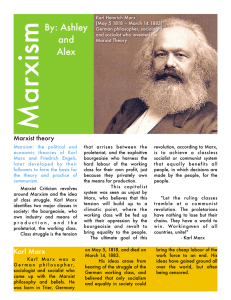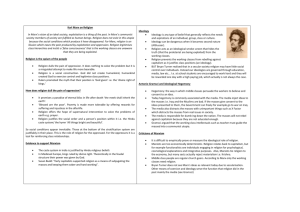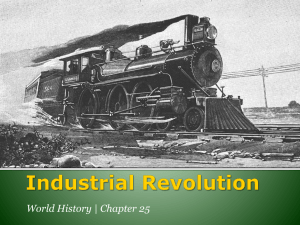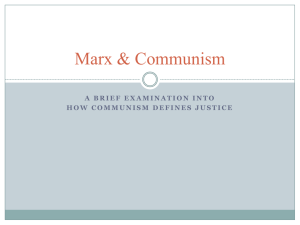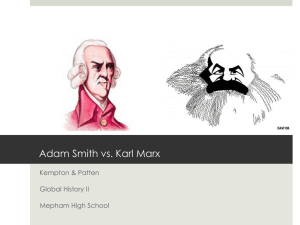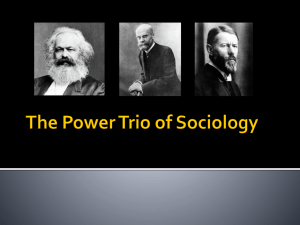Critical Cultural Theory
advertisement
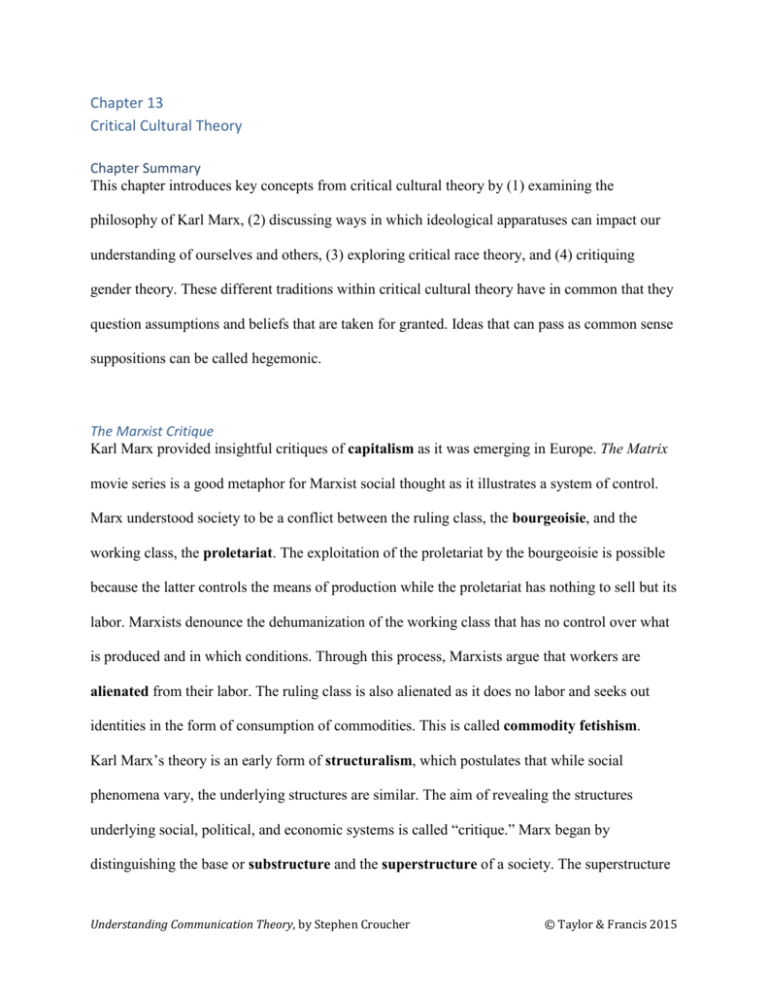
Chapter 13 Critical Cultural Theory Chapter Summary This chapter introduces key concepts from critical cultural theory by (1) examining the philosophy of Karl Marx, (2) discussing ways in which ideological apparatuses can impact our understanding of ourselves and others, (3) exploring critical race theory, and (4) critiquing gender theory. These different traditions within critical cultural theory have in common that they question assumptions and beliefs that are taken for granted. Ideas that can pass as common sense suppositions can be called hegemonic. The Marxist Critique Karl Marx provided insightful critiques of capitalism as it was emerging in Europe. The Matrix movie series is a good metaphor for Marxist social thought as it illustrates a system of control. Marx understood society to be a conflict between the ruling class, the bourgeoisie, and the working class, the proletariat. The exploitation of the proletariat by the bourgeoisie is possible because the latter controls the means of production while the proletariat has nothing to sell but its labor. Marxists denounce the dehumanization of the working class that has no control over what is produced and in which conditions. Through this process, Marxists argue that workers are alienated from their labor. The ruling class is also alienated as it does no labor and seeks out identities in the form of consumption of commodities. This is called commodity fetishism. Karl Marx’s theory is an early form of structuralism, which postulates that while social phenomena vary, the underlying structures are similar. The aim of revealing the structures underlying social, political, and economic systems is called “critique.” Marx began by distinguishing the base or substructure and the superstructure of a society. The superstructure Understanding Communication Theory, by Stephen Croucher © Taylor & Francis 2015 is made up of mechanisms to influence individuals’ behaviors violently or ideologically. The Marxist theorist Althusser refers to violent methods of social control as repressive state apparatuses, and ideological methods as ideological state apparatuses. Repressive state apparatuses are overt strategies of repression that are not effective in the long-term. Ideological state apparatuses are covert ways of controlling individuals through ideology by manipulating what they regard as real. Getting people to accept one reality as the truth is a process Marxists call interpellation. Therborn (1980) argued that ideology functions on three levels by defining (1) what exists, (2) what is good, and (3) what is possible. Critical Theory In the twentieth century, the members of the Frankfurt School developed Marx’s thoughts in important ways, leading to the emergence of critical theory. Some of the main characteristics of critical theory are that (1) it is multidisciplinary, (2) it is used to produce changes and improvements in the condition of human kind, and (3) it is ongoing and reflexive. All critical approaches focus on practical implications rather than abstract theorizing. In communication studies, the emphasis put on praxis unfolds along three lines: (1) consciousness raising, (2) contemporary orientation, and (3) centering the margins. One of the most important extensions of critical theory is postmodernism, which, for instance, includes critical race theory, critical feminist theory, and critical queer theory. Critical race theory emphasizes race over class conflict. Postcolonialism looks at communications practices from the perspective of colonized and previously colonized people. Critical race theory pays attention to racism, which can be understood as prejudice plus power. Discrimination is another important concept though contemporary critical theorists prefer the word privilege to cast light on covert discrimination. Understanding Communication Theory, by Stephen Croucher © Taylor & Francis 2015 Poststructuralist scholar Foucault had a strong influence on the study of knowledge, or epistemology. Foucault examined the formation of knowledge and power through discursive practices. Foucault’s approach applies to gender theory broadly. Contemporary approaches to gender theory are deconstructionist. That is, they set out to break down discourses through which knowledge leading to the oppression of people is constructed. Feminists want to expose ideologies that do not take women seriously—such as misogyny—and that promote men while undermining women—such as patriarchy. Three waves of feminism can be identified in the US. The first wave (1848–1928) fought for women’s enfranchisement, the second wave (1961– 1986) focused on the removal of legal obstacles to gender equality, the third wave (since the 1990s) broadened the goals of the movements to include gay, transgender, and women-of-color rights. Feminism has long distinguished between sex and gender, sex referring to biological attributes gender referring to socially constructed attributes and practices associated with a particular sex. Butler’s theory is particularly important in communication studies since it emphasizes the importance of reverse discourse, or counter-narratives, to challenge hegemonic norms. Like other critical approaches, critical gender theory regards identity as being performative (what we do) rather than essential (who we are). Understanding Communication Theory, by Stephen Croucher © Taylor & Francis 2015


